The name refered to just the column which stood at 24' and supported a multitude
of different bracket styles. The brackets were named after the towns and cities in which they were first installed.
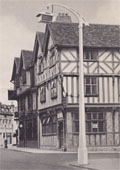
|
Avenue (with Shakespeare Bracket) (1936)
Concrete
25' (to light)
The column (pictured) was fitted with
the Shakespeare bracket.
The column was later renamed the Avenue 4D.
Gallery
1936 Advert
1936 Journal
1938 Catalogue
1939 Journal
|
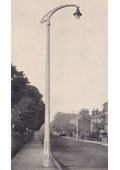
|
Avenue 4D (with Shakespeare Bracket / 5 Ft. Arm) (1937)
Concrete
25' (to light)
Registered Design: No. 813529
This column was originally sold as the Avenue but by 1937 was
now the Avenue 4D.
Columns available in 23' 6", 22' and 20' 6" heights with 21" x 8" door with teak backing
panel. Brackets described include the Canop (3' 6") (designed with Mr. Wm. L. Whittle, Surveyor, Hitchin),
Shakespeare (6') and Eagle (4' 6") - 1937 Programme
These columns and brackets were also rebadged and sold by the GEC
and sold as part of their concrete column range. (It was marketed as the Avenue Z4720 column).
The bracket was rebranded the 5 Ft. Bracket a year later.
The Avenue 4D was now approved by the Royal Fine Art Commission. - 1939 Programme
Advertisement: Some Towns Using Our Columns (1937)
Advertisement: A Concrete Utilities Design (1938)
Advertisement: Modern Lamp Columns (1938)
1938 Catalogue
1938 Catalogue
Advertisement: Concrete Utilities (1939)
Advertisement: Southern Electricity Service (1939)
Advertisement: Concrete Lamp Columns (1943)
Advertisement: Concrete Utilities (1945)
|
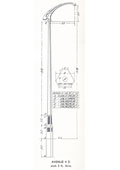
|
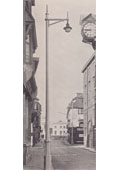
|
Broadway (with 3 Ft. Arm) (1936)
Concrete
25' (to light)
Registered Design: No 813530
The Broadway column was mentioned as being installed in Hertford. It is
25'6" high with a 3'6" projection.
1936 Journal
1938 Catalogue
|
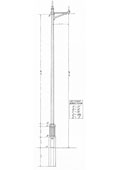
|
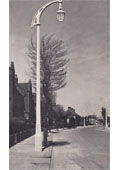
|
Avenue 3D (with R. L. Bracket / Canop Bracket / 3 Ft. 6 In. Bracket) (1937)
Concrete
25' (to light)
Registered Design: No. 807127
The Avenue 3D was the same height as the Avenue 4D which allowed it to be used on Group A routes and
support the full range of brackets. However, it was slightly slimmer, so was probably provided as an option for
smaller outreach brackets, enabling all the dimensions to be kept in proportion.
More significantly the Avenue 3D had a larger base compartment.
This allowed it to accommodate extra components such as winches, which is why the Avenue 3D was often
pictured with winch gear.
The bracket may have been called the Canop Bracket.
An Avenue 3D of height 20' 6" with RL Type bracket (for Raising And Lowering gear)
was exhibited at Folkestone in 1937 - 1937 Programme
1937 APLE Conference Programme
1938 Catalogue
|
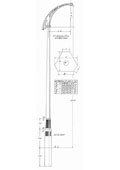
|
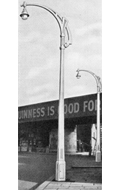
|
Avenue 4D (with Fulham Bracket) (1937)
Concrete
25' (to light)
The Fulham Bracket was originally desgined for Fulham.
These columns and brackets were also rebadged and sold by the GEC
and sold as part of their concrete column range. (It was marketed as the Fulham Z4725 column).
1937 Advert
|
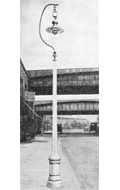
|
Eddystone (1937)
Concrete
15' (to light)
Believed to be called the Eddystone column as it's mentioned in a journal.
1937 Journal
Advertisement: Concrete Utilities (1937)
|
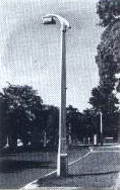
|
Avenue 2D (with Banstead Bracket) (1937)
Concrete
15' (to light)
First appears, unamed, in an advert from 1937 installed in Banstead.
The C.U. Museum has an example of a Avenue 2D Square which has a square profile instead of triangular. This is fitted with
an 1' 6" Avenue Bracket which is the same as the Banstead Bracket.
Advertisement: Concrete Utilities (1937)
1938 Catalogue
Advertisement: A Concrete Utilities Design (1939)
Concrete Utilities Museum.
|
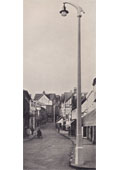
|
Avenue 4D (with 2 Ft. 6 In. Arm) (1937)
Concrete
25' (to light)
Registered Design: No. 807127
These columns and brackets were also rebadged and sold by the GEC
and sold as part of their concrete column range. (It was marketed as the Ware Z4721 column
and the picture shows the GEC Z8005 lantern).
Advertisement: A Concrete Utilities Design (1938)
1938 Catalogue
1938 Catalogue
1938 Catalogue
Advertisement: A Concrete Utilities Design (1939)
|
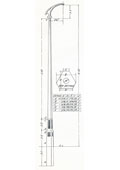
|
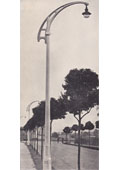
|
Avenue 4D (with Shakespeare Bracket / 6 Ft. Arm) (1938)
Concrete
25' (to light)
Registered Design: No. 813531
The bracket may have been called the Shakespeare bracket.
1938 Catalogue
|
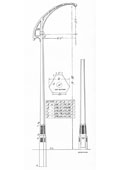
|
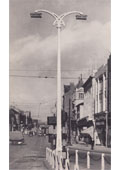
|
Avenue Square (with Double 4 Ft. Arm) (1937)
Concrete
25' (to light)
One of the firm's most popular designs.
1937 Advert
1938 Catalogue
1938 Catalogue
1939 Journal
|
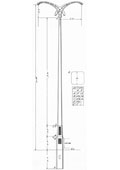
|
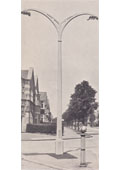
|
Avenue Square (with Double 6 Ft. Arm) (1937)
Concrete
25' (to light)
1937 Advert
1937 Journal
1938 Catalogue
|
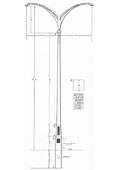
|
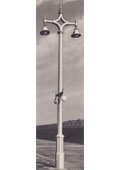
|
Blackpool New Type (1937)
Concrete
25' (to light)
Designed for Princes Way, Blackpool.
1938 Catalogue
|
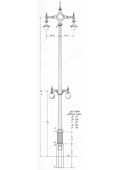
|
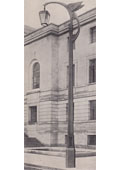
|
Avenue 4D / Avenue 4D Special (with 4 Ft. 6 In. Bird / Eagle Bracket) (1937)
Concrete
25' (to light)
Registered Design: No. 814505
The column was also sometimes called the Avenue 4D Special.
Bracket was possibly also called the Eagle bracket. - 1937 Programme
The building is Hackney Town Hall
where two of these columns were erected. They were later saved and donated to CU Phosco museum.
The most famous installation was of 75 units along Morecombe Promenade which was probably installed in late
1937/early 1938. This was covered in the 1938 Journal
of Public Lighting.
1937 Programme
1938 Catalogue
1938 Journal
Gallery
|
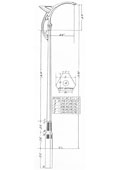
|

|
Civictus (1937)
Concrete
25' (to light)
This column and bracket were installed in Watford by 1937. Its base and column design is similar to the
Liverpool No. 1. The same columns and lanterns were installed in front of the Civic Centre,
Southampton.
1937 Advert
1938 Catalogue
1938 Catalogue
1939 Journal
|
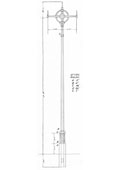
|
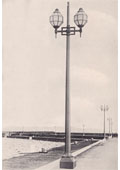
|
??? (1938)
Concrete
25' (to light)
Installed in Dublin.
1938 Catalogue
|
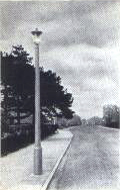
|
Utility Major (1938)
Concrete
|
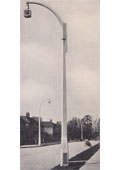
|
Avenue 4D (with 6 Ft. New Arc Arm / Arc 1 Bracket) (1938)
Concrete
25' (to light)
Registered Design: No. 826968
Approved by The Royal Fine Arts Commission
A 4' projection New Arc Bracket, registered design No. 821441/2, was exhibited
at Bournemouth in 1938. - 1938 Programme
The column and bracket was to be exhibited at the cancelled Glasgow exhibition (1939).
Was later called the Arc 1 Bracket.
1938 Catalogue
Advertisement: A Concrete Utilities Design (1939)
1945 Paper
|
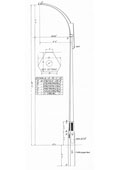
|
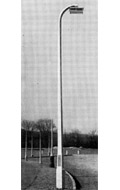
|
Avenue 3D (with Utility Bracket) (1939)
Concrete
Approved by The Royal Fine Arts Commission
The Avenue 3D was now approved by the Royal Fine Art Commission. The column was to be exhibited with the
Utility bracket at the cancelled Glasgow exhibition - 1939 Programme
Gallery
1939 Journal
|
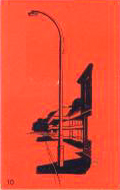
|
Avenue 3D Arc 2 (1940)
Concrete
Shown in the CU catalogue as 1940 design - but the firm would've been involved in the
war effort so this date is disputed. The Arc 2 bracket was probably a post-war design.
Advertisement: It's The Outline That Counts
|
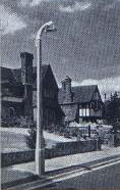
|
Avenue 2D Arc 2 (1941)
Concrete
Shown in the CU catalogue as 1941 design - but the firm would've been involved in the
war effort so this date is disputed. The Arc 2 bracket was probably a post-war design.
|
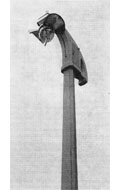
|
Sugg C.U. (1946)
Concrete
15'
Special concrete column and bracket (a modification of the 1' 6" Avenue Bracket) for the
Sugg 8000 lamp. The bracket includes the control equipment. Sold by Sugg as either
the Sugg C.U. bracket or the 8000 Type 'G'.
1946 Conference Programme
1946 Paper
1947 Advert
1947 Journal
|
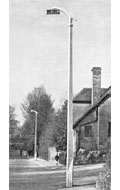
|
Avenue 3DNN (with 2ft. 6in. Avenue bracket) (1946)
Concrete
25'
Narrow base design. Occupies only 9½-in across the pavement and intended for
use where space is restricted.
1946 Conference Programme
1946 Journal
1947 Advert
|
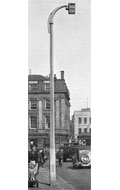
|
Avenue 3DN (with Arc 2 bracket) (1947)
Concrete
25'
Narrow base design (9½in.). Includes "the latest pattern Arc II bracket.'
1947 Advert
1948 catalogue
|
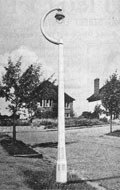
|
Avenue 2D with ??? bracket (1947)
Concrete
15'
1947 Advert
|

|
Avenue 4D ??? (Custom) (1947)
Concrete
25'
Specially produced columns for single and double mounted prototype GEC 7-tube fluorescent lanterns for the
Brompton Road installation.
1947 Journal
|

|
Avenue 4D ??? (Custom) (1947)
Concrete
25'
Specially produced columns for the BTH SL 753 3-tube fluorescent lantern.
1947 Conference
1947 Journal
|

|
Avenue 4D ??? (Custom) (1947)
Concrete
25'
Specially produced columns for the GEC Z 8481: Four-Eighty 4-tube fluorescent lantern. Two tubes project from
the column on which the lanterns are clamped. The lantern head butts against the column.
1947 Conference
1947 Journal
|
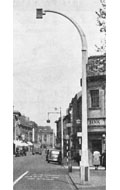
|
Avenue 4D with 6.0 Ft. Arc II Bracket (1947)
Concrete
Advertisement: A Concrete Utilities Design
|
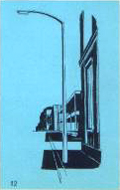
|
Avenue 3DNN Arc 3 (1948)
Concrete
Gallery
Advertisement: The Designs In World Wide Demand
|
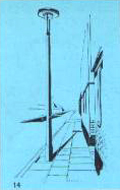
|
Highfield Manor (1949)
Concrete
Special design for Liverpool
|
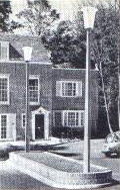
|
Estate Minor 'X' (1950)
Concrete
|
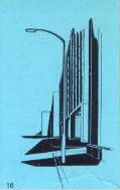
|
Highway (1952)
Concrete
|

|
Byway (1954)
Concrete
Advertisement: The Designs In World Wide Demand
|
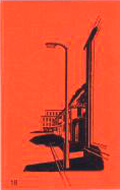
|
Estate Minor Arc 3 (1955)
Concrete
Advertisement: The Designs In World Wide Demand
|
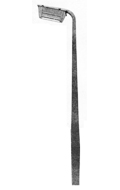
|
Broadcrete 500 (1955)
Concrete
Originally manufactured by Tarslag
Advertisement: The Original
|
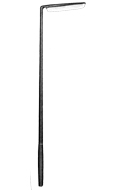
|
Highway 'X' (1956)
Concrete
25'
Public Lighting #92
Advertisement: Elegance Simplicity Service
Advertisement: Elegance Simplicity Service
Advertisement: Centifugally Spun Concrete Lighting Columns
Advertisement: The Designs In World Wide Demand
|
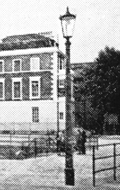
|
Fluted (1956)
Concrete
15'
Public Lighting #92
Advertisement: The Georgian Lantern
Advertisement: The Designs In World Wide Demand
|

|
Catenary (1956)
Concrete
25'
Public Lighting #92
|
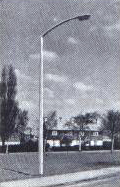
|
Highway 'X' S.B. (1956)
Concrete
Gallery
|
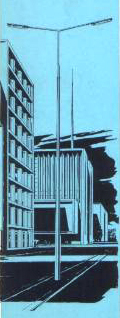
|
New Highway (1960)
Concrete
30' - 35'
Advertisement: The New Highway
Advertisement: For 30 ft. & 35 ft.
|
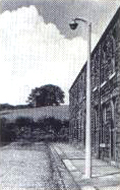
|
Byway 'X' Arc 4 (1961)
Concrete
|



